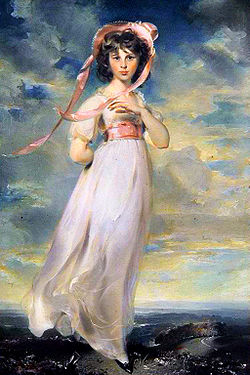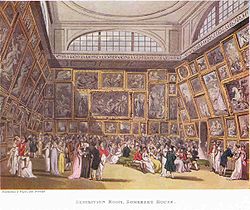
Pinkie (Lawrence painting)
Encyclopedia

Portrait
thumb|250px|right|Portrait of [[Thomas Jefferson]] by [[Rembrandt Peale]], 1805. [[New-York Historical Society]].A portrait is a painting, photograph, sculpture, or other artistic representation of a person, in which the face and its expression is predominant. The intent is to display the likeness,...
of 1794 by Thomas Lawrence
Thomas Lawrence (painter)
Sir Thomas Lawrence RA FRS was a leading English portrait painter and president of the Royal Academy.Lawrence was a child prodigy. He was born in Bristol and began drawing in Devizes, where his father was an innkeeper. At the age of ten, having moved to Bath, he was supporting his family with his...
in the permanent collection of The Huntington at San Marino, California
San Marino, California
San Marino is a small, affluent city in Los Angeles County, California. Incorporated in 1913, the City founders designed the community to be uniquely residential, with expansive properties surrounded by beautiful gardens, wide streets, and well maintained parkways...
where it hangs opposite The Blue Boy
The Blue Boy
The Blue Boy is an oil painting by Thomas Gainsborough. Perhaps Gainsborough's most famous work, it is thought to be a portrait of Jonathan Buttall, the son of a wealthy hardware merchant, although this was never proved...
by Thomas Gainsborough
Thomas Gainsborough
Thomas Gainsborough was an English portrait and landscape painter.-Suffolk:Thomas Gainsborough was born in Sudbury, Suffolk. He was the youngest son of John Gainsborough, a weaver and maker of woolen goods. At the age of thirteen he impressed his father with his penciling skills so that he let...
. These two works are the centerpieces of the institute's art collection, which specializes in 18th-century English portraiture. The painting is an elegant depiction of Sarah Barrett Moulton, who was about eleven years old when painted. Her direct gaze and the loose, highly-movemented brushwork give the portrait a lively immediacy.
Origin
Sarah Goodin Barrett Moulton was born in 1783 in JamaicaJamaica
Jamaica is an island nation of the Greater Antilles, in length, up to in width and 10,990 square kilometres in area. It is situated in the Caribbean Sea, about south of Cuba, and west of Hispaniola, the island harbouring the nation-states Haiti and the Dominican Republic...
. She was the daughter of Charles Barrett Moulton, a wealthy plantation owner
Barrett family of Jamaica
The Barrett family played an important role in the history of Jamaica. Hercie Barrett and family members migrated from England, landing on the island of Jamaica in 1655. In the years that followed, family members acquired substantial wealth and influence...
. Lawrence's portrait was a commission by her grandmother at the time Sarah left Jamaica with her brothers to complete her education in England
England
England is a country that is part of the United Kingdom. It shares land borders with Scotland to the north and Wales to the west; the Irish Sea is to the north west, the Celtic Sea to the south west, with the North Sea to the east and the English Channel to the south separating it from continental...
. The portrait's title and obvious visual pun
Visual pun
A visual pun is a pun involving an image or images .Visual puns in which the image is at odds with the inscription are common in Dutch gable stones as well as in cartoons such as Lost Consonants or The Far Side...
s refer to Sarah's family nickname, "Pinkie". She died on April 23, 1795, one year after the portrait was completed, probably of whooping cough, contracted from one of her brothers.

Royal Academy summer exhibition
The Summer Exhibition is an open art exhibition held annually by the Royal Academy in Burlington House, Piccadilly in central London, England, during the summer months of June, July, and August...
. According to an official Huntington Library publication:
Sarah's brother Edward, who later owned the portrait, changed his surname to Moulton-Barrett. He became the father of poet Elizabeth Barrett Browning
Elizabeth Barrett Browning
Elizabeth Barrett Browning was one of the most prominent poets of the Victorian era. Her poetry was widely popular in both England and the United States during her lifetime. A collection of her last poems was published by her husband, Robert Browning, shortly after her death.-Early life:Members...
. The painting was one of the last acquisitions of California
California
California is a state located on the West Coast of the United States. It is by far the most populous U.S. state, and the third-largest by land area...
land developer Henry E. Huntington
Henry E. Huntington
Henry Edwards Huntington was a railroad magnate and collector of art and rare books. Born in Oneonta, New York, Huntington settled in Los Angeles, where he owned the Pacific Electric Railway as well as substantial real estate interests...
in 1927. In 1934 the Huntington foundation constructed a new main gallery as an addition to the former residence for the collection's major portraits. Except for brief intervals during traveling exhibitions, Pinkie has hung there since that time.
Relationship to The Blue Boy


The Blue Boy
The Blue Boy is an oil painting by Thomas Gainsborough. Perhaps Gainsborough's most famous work, it is thought to be a portrait of Jonathan Buttall, the son of a wealthy hardware merchant, although this was never proved...
. According to Patricia Failing, author of Best-Loved Art from American Museums, “no other work by a British artist enjoys the fame of The Blue Boy.” Pinkie and The Blue Boy are often paired in popular esteem; some gallery visitors mistake them for contemporary works by the same artist. Actually the two were created by different painters a quarter century apart, and the subjects' dress styles are separated by over one hundred fifty years. Jonathan Buttall, who posed for Gainsborough's portrait, wears a period costume of the early 17th century as an homage to Flemish Baroque painter Anthony Van Dyck
Anthony van Dyck
Sir Anthony van Dyck was a Flemish Baroque artist who became the leading court painter in England. He is most famous for his portraits of Charles I of England and his family and court, painted with a relaxed elegance that was to be the dominant influence on English portrait-painting for the next...
, whom Gainsborough held in particular esteem. Sarah Moulton wears the contemporary fashion of 1794. The two works had no association until Henry Huntington purchased them in the 1920s.
Nonetheless, the two are so well matched that William Wilson, author of The Los Angeles Times
Los Angeles Times
The Los Angeles Times is a daily newspaper published in Los Angeles, California, since 1881. It was the second-largest metropolitan newspaper in circulation in the United States in 2008 and the fourth most widely distributed newspaper in the country....
Book of California Museums, calls them "the Romeo and Juliet
Romeo and Juliet
Romeo and Juliet is a tragedy written early in the career of playwright William Shakespeare about two young star-crossed lovers whose deaths ultimately unite their feuding families. It was among Shakespeare's most popular archetypal stories of young, teenage lovers.Romeo and Juliet belongs to a...
of Rococo
Rococo
Rococo , also referred to as "Late Baroque", is an 18th-century style which developed as Baroque artists gave up their symmetry and became increasingly ornate, florid, and playful...
portraiture" and notes that their association borders on cliché:

